Environmental and Energetic Evaluation of Refuse-Derived Fuel Gasification for Electricity Generation
Abstract
1. Introduction
2. Materials and Methods
2.1. Gasification Model
- Ashes are inert and do not participate in chemical balance.
- The residence time is long enough to allow the chemical balance to be reached, and thus, the gasification process occurs in a steady state.
- The gasification reactor is completely isothermal.
- The gasifier operating pressure is 1.0 atm.
- The char is composed solely of carbon.
- The formation of tar and heavy hydrocarbons during gasification is negligible.
- Undesirable chemical compounds were separated through the method of adsorption using iron oxides.
- Clean syngas was cooled to 25 °C in a cooler.
- No heat losses are considered.
2.2. Validation of Gasification Model
2.3. Gas Microturbine Model
2.4. Environmental Impact Assessment
3. Results and Discussion
3.1. Gasification Process Analysis
3.2. Gas Microturbine Analysis
3.3. Environmental Assessment
4. Conclusions
Author Contributions
Funding
Institutional Review Board Statement
Informed Consent Statement
Data Availability Statement
Conflicts of Interest
References
- ABRELPE. Panorama dos Resíduos Sólidos no Brasil 2020; ABRELPE: São Paulo, Brazil, 2020. [Google Scholar]
- SEEG Sistema de Estimativas de Emissões e Remoções de Gases de Efeito Estufa—Emissões Do Setor De Resíduos. Available online: https://seeg.eco.br/ (accessed on 10 February 2021).
- Gouveia, N. Resíduos sólidos urbanos: Impactos socioambientais e perspectiva de manejo sustentável com inclusão social. Cien. Saude Colet. 2012, 17, 1503–1510. [Google Scholar] [CrossRef]
- Mamede, M.C.D.S. Avaliação Econômica e Ambiental do Aproveitamento Energético de Resíduos Sólidos no Brasil; Universidade Estadual de Campinas: Campinas, Brazil, 2010. [Google Scholar]
- Instituto Brasileiro de Meio Ambiente Instrução Normativa No 13, de 18 de Dezembro de 2012. Available online: https://www.legisweb.com.br/legislacao/?id=248656 (accessed on 23 January 2021).
- Yaman, C.; Anil, I.; Alagha, O. Potential for greenhouse gas reduction and energy recovery from MSW through different waste management technologies. J. Clean. Prod. 2020, 264, 121432. [Google Scholar] [CrossRef]
- Beyene, H.D.; Werkneh, A.A.; Ambaye, T.G. Current updates on waste to energy (WtE) technologies: A review. Renew. Energy Focus 2018, 24, 1–11. [Google Scholar] [CrossRef]
- Ramos, A.; Monteiro, E.; Silva, V.; Rouboa, A. Co-gasification and recent developments on waste-to-energy conversion: A review. Renew. Sustain. Energy Rev. 2018, 81, 380–398. [Google Scholar] [CrossRef]
- Martínez González, A.; Silva Lora, E.E.; Escobar Palacio, J.C. Syngas production from oil sludge gasification and its potential use in power generation systems: An energy and exergy analysis. Energy 2019, 169, 1175–1190. [Google Scholar] [CrossRef]
- Couto, N.D.; Silva, V.B.; Rouboa, A. Assessment on steam gasification of municipal solid waste against biomass substrates. Energy Convers. Manag. 2016, 124, 92–103. [Google Scholar] [CrossRef]
- Lensu, T.; Alakangas, E. Small-Scale Electricity Generation from Renewable Energy Sources: A Glance at Selected Technologies, Their Market Potential and Future Prospects; VTT Technical Research Centre of Finland: Espoo, Finland, 2010. [Google Scholar]
- Sarmiento, A.L.E.; de Oliveira, W.; Camacho, R.G.R. Influence of the vortex design method in the performance characteristics of reversible axial rotors. J. Brazilian Soc. Mech. Sci. Eng. 2017, 39, 1575–1588. [Google Scholar] [CrossRef]
- Perna, A.; Minutillo, M.; Jannelli, E.; Cigolotti, V.; Nam, S.W.; Yoon, K.J. Performance assessment of a hybrid SOFC/MGT cogeneration power plant fed by syngas from a biomass down-draft gasifier. Appl. Energy 2018, 227, 80–91. [Google Scholar] [CrossRef]
- Benini, E. Progress in Gas Turbine Performance, 1st ed.; Benini, E., Ed.; IntechOpen: London, UK, 2013; ISBN 978-953-51-1166-5. [Google Scholar]
- Konečná, E.; Teng, S.Y.; Máša, V. New insights into the potential of the gas microturbine in microgrids and industrial applications. Renew. Sustain. Energy Rev. 2020, 134, 110078. [Google Scholar] [CrossRef]
- Capstone. Capstone MicroTurbine® Fuel Requirements Technical Reference; Capstone: Chatsworth, CA, USA, 2014. [Google Scholar]
- Khatri, P.; Jain, S.; Pandey, S. A cradle-to-gate assessment of environmental impacts for production of mustard oil using life cycle assessment approach. J. Clean. Prod. 2017, 166, 988–997. [Google Scholar] [CrossRef]
- Venturini, O.J.; Júnior, J.C.F.; Palacio, J.C.E.; Batlle, E.A.O.; Carvalho, M.; Lora, E.E.S. Indicators for sustainability assessment of biofuels: Economic, environmental, social, and technological dimensions. In Biofuels for a More Sustainable Future: Life Cycle Sustainability Assessment and Multi-Criteria Decision Making; Ren, J., Scipioni, A., Manzardo, A., Liang, H., Eds.; Elsevier: Amsterdam, The Netherlands, 2020; pp. 73–113. ISBN 978-0-12-815581-3. [Google Scholar]
- Rabou, L.P.L.M.; Grift, J.M.; Conradie, R.E.; Fransen, S. Micro Gas Turbine Operation with Biomass Producer Gas and Mixtures of Biomass Producer Gas and Natural Gas. Energy Fuels 2008, 22, 1944–1948. [Google Scholar] [CrossRef]
- Corrêa, P.S.P.; Zhang, J.; Lora, E.E.S.; Andrade, R.V.; de Mello e Pinto, L.R.; Ratner, A. Experimental study on applying biomass-derived syngas in a microturbine. Appl. Therm. Eng. 2019, 146, 328–337. [Google Scholar] [CrossRef]
- Násner Lozano, A.M.; Silva Lora, E.E.; Escobar Palacio, J.C.; Rocha, M.H.; Restrepo, J.C.; Venturini, O.J.; Ratner, A. Refuse Derived Fuel (RDF) production and gasification in a pilot plant integrated with an Otto cycle ICE through Aspen plusTM modelling: Thermodynamic and economic viability. Waste Manag. 2017, 69, 187–201. [Google Scholar] [CrossRef] [PubMed]
- Dong, J.; Tang, Y.; Nzihou, A.; Chi, Y.; Weiss-Hortala, E.; Ni, M. Life cycle assessment of pyrolysis, gasification and incineration waste-to-energy technologies: Theoretical analysis and case study of commercial plants. Sci. Total Environ. 2018, 626, 744–753. [Google Scholar] [CrossRef]
- Acar, M.C.; Böke, Y.E. Simulation of biomass gasification in a BFBG using chemical equilibrium model and restricted chemical equilibrium method. Biomass Bioenergy 2019, 125, 131–138. [Google Scholar] [CrossRef]
- Aydin, E.S.; Yucel, O.; Sadikoglu, H. Development of a semi-empirical equilibrium model for downdraft gasification systems. Energy 2017, 130, 86–98. [Google Scholar] [CrossRef]
- Sittisun, P.; Tippayawong, N.; Pang, S. Biomass gasification in a fixed bed downdraft reactor with oxygen enriched air: A modified equilibrium modeling study. Energy Procedia 2019, 160, 317–323. [Google Scholar] [CrossRef]
- Bhattacharyya, D.; Turton, R.; Zitney, S.E. Steady-State Simulation and Optimization of an Integrated Gasification Combined Cycle Power Plant with CO2 Capture. Ind. Eng. Chem. Res. 2011, 50, 1674–1690. [Google Scholar] [CrossRef]
- Roussanaly, S.; Brunsvold, A.L.; Hognes, E.S.; Jakobsen, J.P.; Zhang, X. Integrated Techno-economic and Environmental Assessment of an Amine-based Capture. Energy Procedia 2013, 37, 2453–2461. [Google Scholar] [CrossRef][Green Version]
- Kuo, P.C.; Wu, W.; Chen, W.H. Gasification performances of raw and torrefied biomass in a downdraft fixed bed gasifier using thermodynamic analysis. Fuel 2014, 117, 1231–1241. [Google Scholar] [CrossRef]
- Campoy, M.; Gómez-Barea, A.; Vidal, F.B.; Ollero, P. Air–steam gasification of biomass in a fluidised bed: Process optimisation by enriched air. Fuel Process. Technol. 2009, 90, 677–685. [Google Scholar] [CrossRef]
- Capstone. Combined Heat and Power Systems Technology Development and Demonstration 370 kW High Efficiency Microturbine; Capstone: Los Angeles, CA, USA, 2015. [Google Scholar]
- Capstone Capstone C200 Microturbine Technical Reference; Capstone: Los Angeles, CA, USA, 2009.
- Malkamäk, M.; Jaatinen-Värri, A.; Honkatukia, J.; Backman, J.; Larjola, J. A High efficiency microturbine concept. In Proceedings of the 11th European Conference on Turbomachinery Fluid dynamics & Thermodynamics, Madrid, Spain, 23–27 March 2015; pp. 1–12. [Google Scholar]
- Saravanamuttoo, H.; Rogers, G.; Cohen, H.; Straznicky, P.; Nix, A. Gas Turbine Theory, 7th ed.; Saravanamuttoo, H., Rogers, G., Cohen, H., Straznicky, P., Nix, A., Eds.; Pearson Education Limited: Harlow, UK, 2017; ISBN 9781-292-09313-0. [Google Scholar]
- Venturini, O.J.; Orozco, D.J.R.; Escobar, J.C.P.; Lora, E.E.S. Performance Evaluation of Microturbines Operating With Second-Generation Biofuels. In Proceedings of the ENCIT 2016, Vitória, Brazil, 7–10 November 2016; ABCM: Vitória, Brazil, 2016; pp. 1–10. [Google Scholar]
- Zhu, P.; Saravanamuttoo, H.I.H. Simulation of an Advanced Twin-Spool Industrial Gas Turbine. J. Eng. Gas Turbines Power 1992, 114, 180–185. [Google Scholar] [CrossRef]
- Grigoratos, T.; Fontaras, G.; Giechaskiel, B.; Zacharof, N. Real world emissions performance of heavy-duty Euro VI diesel vehicles. Atmos. Environ. 2019, 201, 348–359. [Google Scholar] [CrossRef]
- Goedkoop, M.; Heijungs, R.; Huijbregts, M.; De Schryver, A.; Struijs, J.; van Zelm, R. ReCiPe 2008: A Life Cycle Impact Assessment Method Which Comprises Harmonised Category Indicators at the Midpoint and the Endpoint Level; Ruimte & Milieu: Amersfoort, The Netherlands, 2009. [Google Scholar]
- Castillo Santiago, Y.; Martínez González, A.; Venturini, O.J.; Yepes Maya, D.M. Assessment of the energy recovery potential of oil sludge through gasification aiming electricity generation. Energy 2021, 215, 119210. [Google Scholar] [CrossRef]
- Lv, P.; Yuan, Z.; Ma, L.; Wu, C.; Chen, Y.; Zhu, J. Hydrogen-rich gas production from biomass air and oxygen/steam gasification in a downdraft gasifier. Renew. Energy 2007, 32, 2173–2185. [Google Scholar] [CrossRef]
- Yepes Maya, D.M.; Silva Lora, E.E.; Vieira Andrade, R.; Ratner, A.; Espinosa Sarmiento, A.L.; de Mello e Pinto, L.R.; Mendes Neto, L.J. Biomass Gasification in Downdraft Dual Stage Reactor by Experimental Analysis and Simulation with CFD Tools. In Proceedings of the 25th European Biomass Conference and Exhibition, Stockholm, Sweden, 12–15 June 2017; pp. 808–816. [Google Scholar]
- Couto, N.D.; Silva, V.B.; Monteiro, E.; Rouboa, A. Assessment of municipal solid wastes gasification in a semi-industrial gasifier using syngas quality indices. Energy 2015, 93, 864–873. [Google Scholar] [CrossRef]
- Tamošiūnas, A.; Jeguirim, M. Char gasification. In Char and Carbon Materials Derived from Biomass; Jeguirim, M., Limousy, L., Eds.; Elsevier: Amsterdam, The Netherlands, 2019; pp. 187–228. ISBN 978-0-12-814893-8. [Google Scholar]
- Ramzan, N.; Ashraf, A.; Naveed, S.; Malik, A. Simulation of hybrid biomass gasification using Aspen plus: A comparative performance analysis for food, municipal solid and poultry waste. Biomass Bioenergy 2011, 35, 3962–3969. [Google Scholar] [CrossRef]
- Cao, Y.; Wang, Q.; Du, J.; Chen, J. Oxygen-enriched air gasification of biomass materials for high-quality syngas production. Energy Convers. Manag. 2019, 199, 111628. [Google Scholar] [CrossRef]
- Islam, M.W. Effect of different gasifying agents (steam, H2O2, oxygen, CO2, and air) on gasification parameters. Int. J. Hydrogen Energy 2020, 45, 31760–31774. [Google Scholar] [CrossRef]
- Basu, P. Biomass Gasification, Pyrolysis, and Torrefaction: Practical Design and Theory, 2nd ed.; Basu, P., Ed.; Elsevier: San Diego, CA, USA, 2013; ISBN 978-0-12-396488-5. [Google Scholar]
- Ismail, T.M.; Ramos, A.; Monteiro, E.; El-Salam, M.A.; Rouboa, A. Parametric studies in the gasification agent and fluidization velocity during oxygen-enriched gasification of biomass in a pilot-scale fluidized bed: Experimental and numerical assessment. Renew. Energy 2020, 147, 2429–2439. [Google Scholar] [CrossRef]
- Liu, L.; Huang, Y.; Cao, J.; Liu, C.; Dong, L.; Xu, L.; Zha, J. Experimental study of biomass gasification with oxygen-enriched air in fluidized bed gasifier. Sci. Total Environ. 2018, 626, 423–433. [Google Scholar] [CrossRef]
- Page, D.; Shaffer, B.; McDonell, V. Establishing Operating Limits in a Commercial Lean Premixed Combustor Operating on Synthesis Gas Pertaining to Flashback and Blowout. In Proceedings of the ASME Turbo Expo 2012: Turbine Technical Conference and Exposition, Copenhagen, Denmark, 11 June 2012; ASME: Copenhagen, Denmark, 2012; pp. 647–656. [Google Scholar]
- Renó, M.L.G.; Del Olmo, O.A.; Palacio, J.C.E.; Lora, E.E.S.; Venturini, O.J. Sugarcane biorefineries: Case studies applied to the Brazilian sugar-alcohol industry. Energy Convers. Manag. 2014, 86, 981–991. [Google Scholar] [CrossRef]
- Nie, Y.; Wu, Y.; Zhao, J.; Zhao, J.; Chen, X.; Maraseni, T.; Qian, G. Is the finer the better for municipal solid waste (MSW) classification in view of recyclable constituents? A comprehensive social, economic and environmental analysis. Waste Manag. 2018, 79, 472–480. [Google Scholar] [CrossRef] [PubMed]
- Evangelisti, S.; Tagliaferri, C.; Clift, R.; Lettieri, P.; Taylor, R.; Chapman, C. Life cycle assessment of conventional and two-stage advanced energy-from-waste technologies for municipal solid waste treatment. J. Clean. Prod. 2015, 100, 212–223. [Google Scholar] [CrossRef]
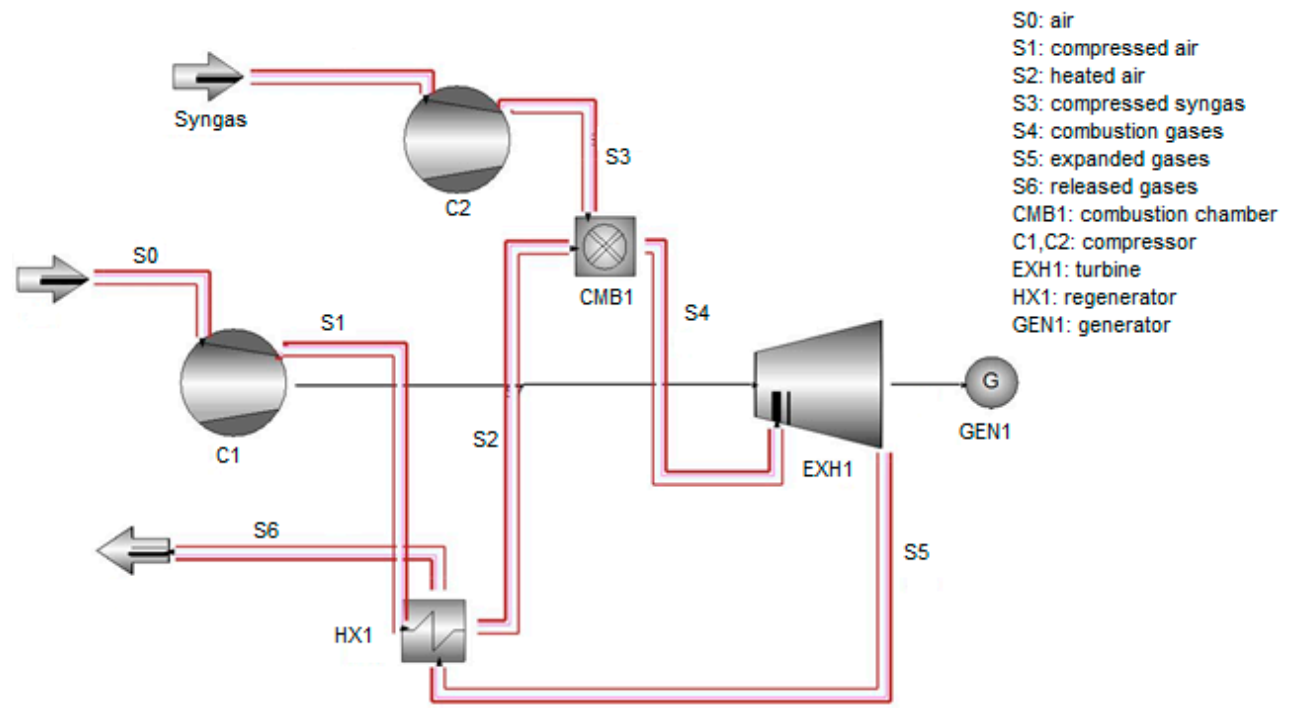
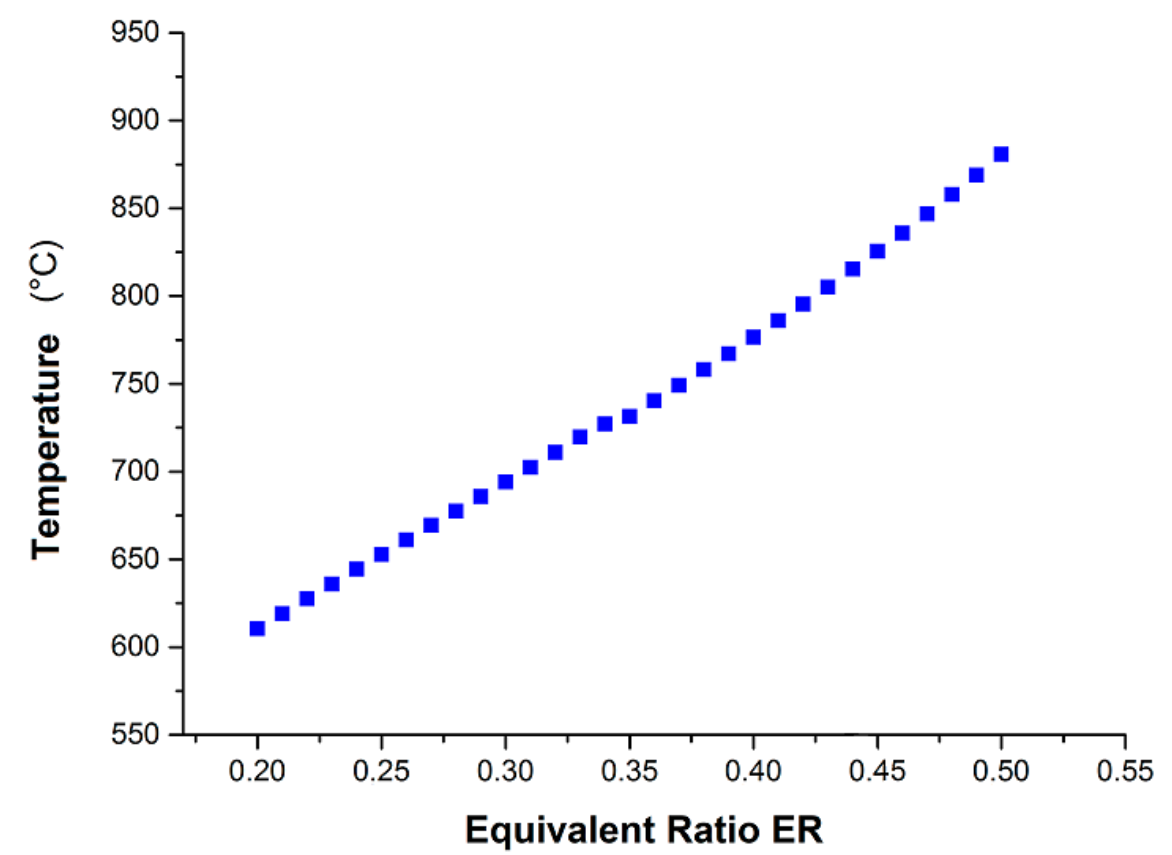

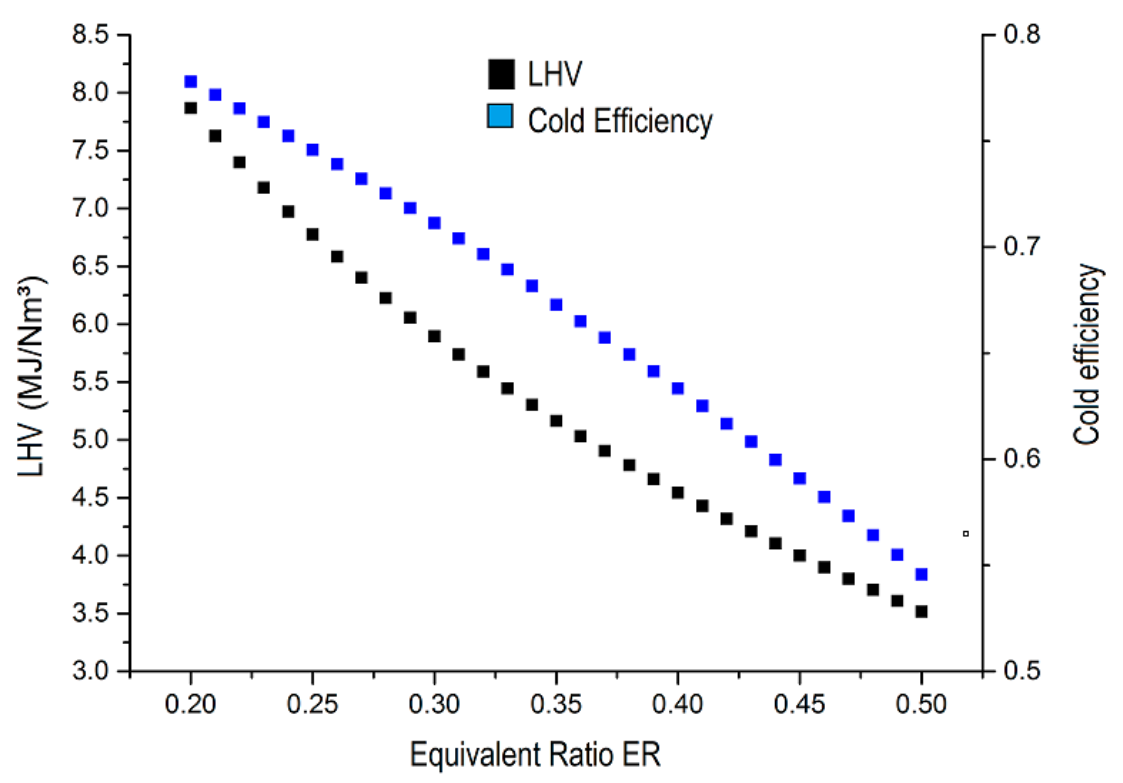

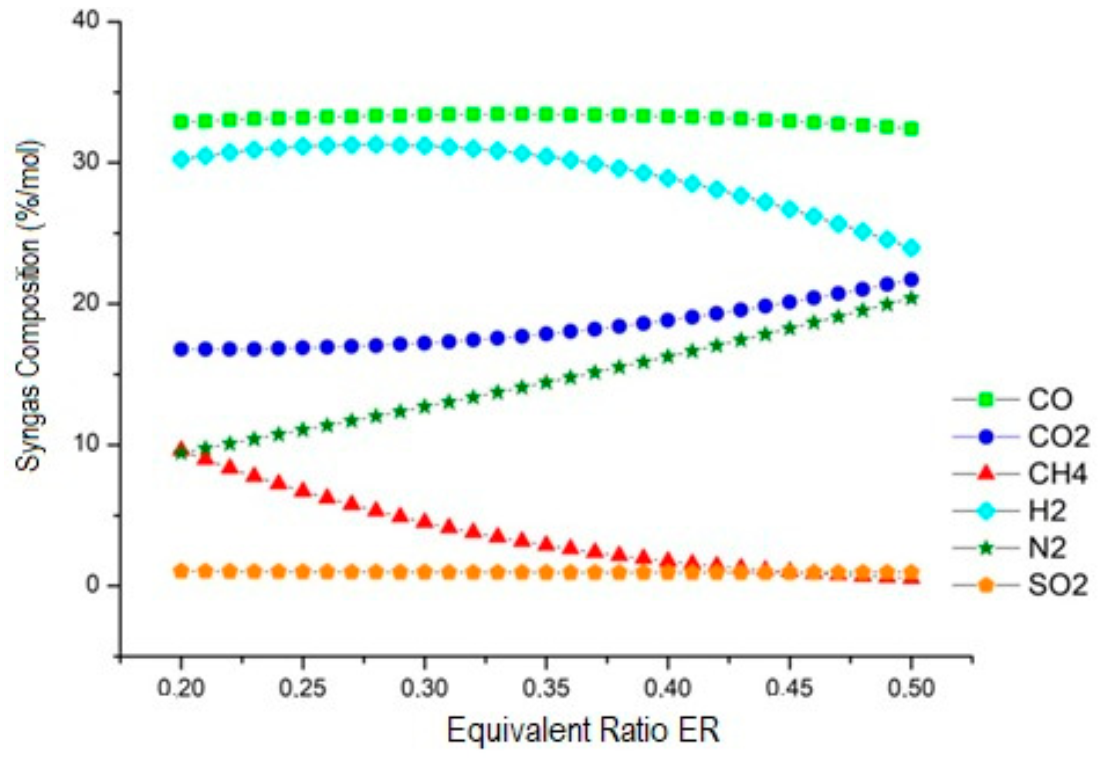

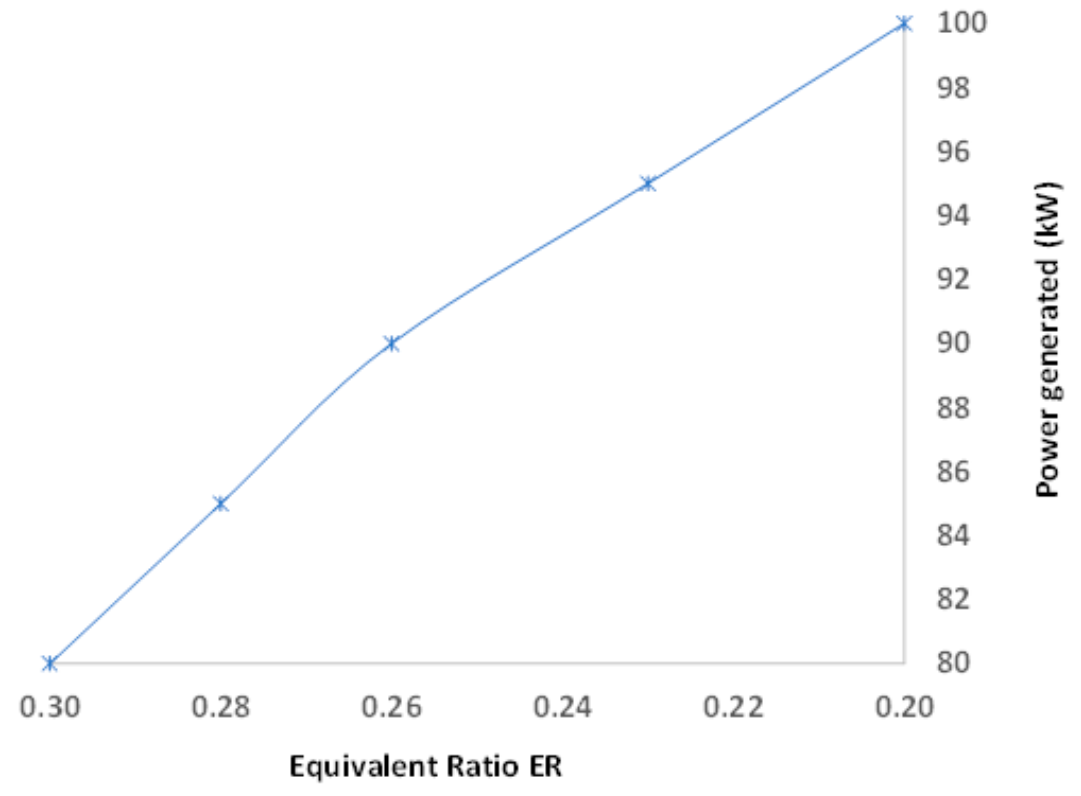


| C | H | O | N | S | Ash | Volatile | FC | Moisture |
|---|---|---|---|---|---|---|---|---|
| 44.91% | 6.45% | 44.82% | 1.7% | 2.12% | 2.43% | 72.58% | 16.70% | 8.29% |
| Parameter | Unit | Value | Parameter | Unit | Value |
|---|---|---|---|---|---|
| Proximate Analysis | Operational Conditions | ||||
| Fixed Carbon | % | 19.5 | Biomass mass flow | kg/h | 21.6 |
| Volatiles | % | 80.0 | Reactor pressure | bar | 1.013 |
| Moisture | % | 6.3 | Average bed temperature | °C | 840 |
| Ash | % | 0.5 | ER | - | 0.24–0.38 |
| Ultimate Analysis | |||||
| Carbon | % | 49.5 | |||
| Hydrogen | % | 5.8 | |||
| Nitrogen | % | 2.0 | |||
| Sulfur | % | 0.1 | |||
| Oxygen | % | 42.1 | |||
| ER | SB | %CO (E) | %CO (M) | %H2 (E) | %H2 (M) | %CO2 (E) | %CO2 (M) | %CH4 (E) | %CH4 (M) | RMS |
|---|---|---|---|---|---|---|---|---|---|---|
| 0.35 | 0.00 | 15.80 | 24.57 | 8.70 | 17.03 | 15.10 | 9.68 | 5.10 | 2.08 | 6.08 |
| 0.33 | 0.22 | 15.40 | 19.30 | 11.90 | 19.26 | 15.90 | 13.96 | 4.80 | 3.27 | 3.89 |
| 0.33 | 0.45 | 13.80 | 14.46 | 13.30 | 20.12 | 17.00 | 17.56 | 4.60 | 4.12 | 3.09 |
| 0.27 | 0.23 | 15.00 | 17.62 | 14.00 | 18.90 | 16.20 | 16.67 | 4.70 | 6.46 | 2.64 |
| 0.27 | 0.43 | 11.90 | 12.96 | 16.20 | 19.67 | 18.60 | 20.12 | 5.30 | 7.28 | 1.97 |
| Parameter | Value | Parameter | Value |
|---|---|---|---|
| Rated power | 200 ± 4 kW | Compressor efficiency | 79% |
| Net efficiency | 33 ± 2% | Turbine efficiency | 82.5% |
| Heat rate (LHV) | 10.9 MJ/kWh | Regenerator effectiveness | 85% |
| Generator efficiency | 93.8% | Regenerator cold side loss | 1.6% |
| Fuel energetic flow | 2400 MJ/h | Regenerator hot side loss | 3.8% |
| Exhaust temperature | 280 °C | Combustion efficiency | 98% |
| Pressure ratio | 4.0 | Turbine inlet temperature | 951 °C |
| Input | Quantity | Output | Quantity |
|---|---|---|---|
| Stage—MSW Transportation | |||
| Diesel | 5.09078 kg | CO2 | 13.74 kg |
| CO | 0.09 kg | ||
| NOx—Nitrogen oxides | 0.01143 kg | ||
| THC—Total hydrocarbons | 0.0189 kg | ||
| PM10—Particulate matter | 0.009324 kg | ||
| Stage—RDF Pretreatment and Gasification | |||
| RDF pretreatment | 44.4 kW | Ash | 2.43 kg |
| Electricity for gasification | 36 kW | ||
| Air | 64.8 kg | ||
| Stage—Electricity Generation from GM | |||
| Syngas | 164.8 kg | CO2 | 25.35 kg |
| SO2 | 7.48 kg | ||
| Electricity | 79.6 kW | ||
| Impact Categories Midpoint | MSW Transportation | Pretreatment MSW/RDF | RDF Gasification | Electric Generation in GM | Unit |
|---|---|---|---|---|---|
| Climate change | 17.0 | 2474.49 | 16.8 | −4360.05 | kg CO2 eq |
| Ozone depletion | 6.55 × 10−10 | 2.83 × 10−7 | 2.30 × 10−9 | −5.07 × 10−7 | kg CFC−11 |
| Terrestrial acidification | 0.03 | 17.74 | 0.144 | −29.84 | kg SO2 eq |
| Freshwater eutrophication | 0 | 0.001 | 1.19 × 10−5 | −0.002 | kg P eq |
| Marine eutrophication | 0.001 | 1.00 | 0.008 | −1.8 | kg N eq |
| Human toxicity | 0.57 | 0.28 | 0.002 | −0.51 | kg 1.4-DB eq |
| Photochemical oxidant formation | 0.04 | 26.54 | 0.21 | −47.43 | kg NMVOC |
| Particulate matter formation | 0.01 | 6.67 | 0.05 | −11.56 | kg PM10 eq |
| Terrestrial ecotoxicity | 2.03 × 10−5 | 0.07 | 0.0006 | 2.03 × 10−5 | kg 1.4-DB eq |
| Freshwater ecotoxicity | 0.07 | 0.11 | 0.0009 | −0.20 | kg 1.4-DB eq |
| Marine ecotoxicity | 0.07 | 0.05 | 0.0004 | −0.09 | kg 1.4-DB eq |
| Ionizing radiation | 0 | 1.04 | 0.008 | −1.87 | kg Bq U235 eq |
| Agricultural land occupation | 0 | 2.45 | 0.02 | −4.39 | m2a |
| Urban land occupation | 0 | 0.09 | 0.0007 | −0.17 | m2a |
| Natural land transformation | 0 | 0.007 | 5.97 × 10−5 | −0.01 | m2 |
| Water depletion | 0 | 239.05 | 1.94 | −428.56 | m3 |
| Metal depletion | 0 | 0.32 | 0.002 | −0.58 | kg Feeq |
| Fossil depletion | 5.35 | 2.36 | 0.02 | −4.23 | kg oileq |
Publisher’s Note: MDPI stays neutral with regard to jurisdictional claims in published maps and institutional affiliations. |
© 2021 by the authors. Licensee MDPI, Basel, Switzerland. This article is an open access article distributed under the terms and conditions of the Creative Commons Attribution (CC BY) license (https://creativecommons.org/licenses/by/4.0/).
Share and Cite
Marques, T.E.; Castillo Santiago, Y.; Renó, M.L.G.; Yepes Maya, D.M.; Sphaier, L.A.; Shi, Y.; Ratner, A. Environmental and Energetic Evaluation of Refuse-Derived Fuel Gasification for Electricity Generation. Processes 2021, 9, 2255. https://doi.org/10.3390/pr9122255
Marques TE, Castillo Santiago Y, Renó MLG, Yepes Maya DM, Sphaier LA, Shi Y, Ratner A. Environmental and Energetic Evaluation of Refuse-Derived Fuel Gasification for Electricity Generation. Processes. 2021; 9(12):2255. https://doi.org/10.3390/pr9122255
Chicago/Turabian StyleMarques, Taís Eliane, York Castillo Santiago, Maria Luiza Grillo Renó, Diego Mauricio Yepes Maya, Leandro Alcoforado Sphaier, Yunye Shi, and Albert Ratner. 2021. "Environmental and Energetic Evaluation of Refuse-Derived Fuel Gasification for Electricity Generation" Processes 9, no. 12: 2255. https://doi.org/10.3390/pr9122255
APA StyleMarques, T. E., Castillo Santiago, Y., Renó, M. L. G., Yepes Maya, D. M., Sphaier, L. A., Shi, Y., & Ratner, A. (2021). Environmental and Energetic Evaluation of Refuse-Derived Fuel Gasification for Electricity Generation. Processes, 9(12), 2255. https://doi.org/10.3390/pr9122255










